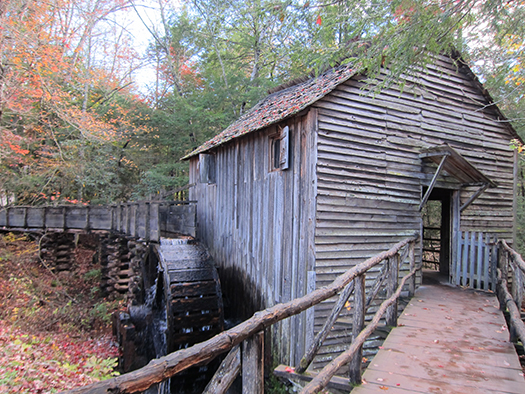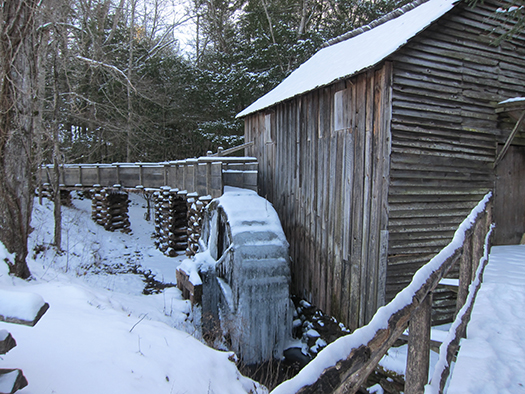
John P. Cable Grist Mill in Cades Cove

John Cable Grist Mill built in the early 1870s.
Corn meal can be purchased at the Cades Cove Visitor Center seasonally
In the early 1870s when John Cable built his mill at the west end of Cades Cove, it was surrounded only by his fields. Like most farmers with gristmills, Cable's milling was a part-time job. Although the mill was open for business on specific days, customers who came at other times could ring a large bell near the mill when they wanted to call John Cable from his fields. Today, Cable Mill has a visitor center plus the Gregg-Cable House and several farm buildings which were moved in from other parts of the cove.
Between the 1850s and 1870s when Cades Cove was at its population peak, four or five mills served its 700 residents. They were powered by water, except for the steam-powered Ledbetter mill, a late-comer built in the early 1920s.

Cable Mill in Winter. Image by Jeaneane Payne
Between the 1850s and 1870s when Cades Cove was at its population peak, four or five mills served its 700 residents. They were powered by water, except for the steam-powered Ledbetter mill, a late-comer built in the early 1920s.
Cable Mill's power comes from Mill Creek, although Cable dug a connecting channel to Forge Creek so that when water levels were low he could tap both streams. A low dam channels water toward the head of the millrace where the first of several water gates allows the miller to regulate the flow of water. The last water gate, on the flume, can be operated by a long lever from within the mill.
Where millrace meets flume, a chunk rack works like a giant wooden comb to keep debris from entering the 235 foot flume, which is braced every few feet to keep the wood from warping. Water in the ground-level flume races along on a slight downward slope until the end, where it angles sharply down to where the mill and its adjacent waterwheel stand. The flume ends at the crest of Cable Mill's wooden waterwheel which rises vertically against the side of the mill. Water from the flume continually drops onto the wheel's buckets, the pressure and weight of the water driving the forty-some buckets downwards, one after another, turning the wheel.
Eleven feet high and five feet wide between its rims, the Cable waterwheel is a classic overshot wheel suited to fast mountain streams. Undershot wheels, used on slow, flat-water rivers of the lowlands, turned as water flowed past the bottom of the wheel. Much more energy efficient, overshot wheels took advantage of mountain streams plunging down steep grades.
Cable Mill, a two-story structure about one-fourth the size of Mingus Mill, consists of an 18- by 20 foot room divided in two: an open space at ground level where customers waited with their grain and a raised platform holding the mill equipment. Beneath the main floor, an unfinished basement houses the gears that move energy from the waterwheel to the millstones. A warming hut used to sit close to the mill so that in winter customers could wait for their meal or flour in relative comfort.
Also missing is the small sawmill that stood nearby and was also powered by water from Mill Creek. Probably no bigger than the gristmill building, the lumber mill used a six-foot sash saw to cut boards for homes, barns, and other buildings. Inside Cable Mill, wheat stones once stood on the millstone platform. What remains are the corn stones which were most vital to the food supply of any rural household in the Smokies.
To grind the vital corn, the power of Cable Mill's water wheel is transferred to the millstone through a series of six gears. One is a bevel gear that changes the direction of rotation from horizontal to vertical. The others are successively smaller gears to turn the millstone faster so that one rotation of the water wheel equals 35 rotations of the millstone.
Although five of the six gears have been replaced by metal, all were originally made of apple wood which is hard enough to hold an edge without cracking. Millers kept the gears greased with beef tallow, the longest-lasting animal fat.
When water hits the overshot wheel at full surge, Cable Mill can produce three bushels (150 pounds) of meal per hour. As the waterwheel turns, its voice as soothing as the sound of running water, the miller pours corn into a two foot square hopper. The hopper drops kernels into a "shoe," a narrow chute that feeds the corn through a hole in the top millstone.
The corn falls between the grooved millstones and is sheared into meal as the top millstone rotates above the stationary bottom stone. By turning a threaded metal rod, the miller can raise or lower the top millstone by a few thousandths of an inch, customizing the grind from coarse cracked corn to fine, floury meal.
Driving Directions:
John P. Cable Grist Mill in Cades Cove:
From Townsend TN, stay on E. Lamar Alexander Parkway until it dead ends (3.5 miles); turn right at Laurel Creek Road and go 7.6 miles where you will go directly into the Cades Cove entrance. The mill is about 5.5 miles from that point.
From Gatlinburg TN, enter the National Park from the Parkway (the main street) in Gatlinburg. Turn right at Sugarlands Visitor Center. Travel 13 miles to the Wye (swimming hole) in Townsend. Continue straight 7.6 miles where you will go directly into the Cades Cove entrance. The mill is about 5.5 miles from that point.
From Pigeon Forge, TN,
take Wears Valley Road (traffic light #1) for 15 miles. Turn left on E. Lamar Alexander Parkway until it dead ends (3.5 miles); turn right at Laurel Creek Road and go 7.6 miles where you will go directly into the Cades Cove entrance. The mill is about 5.5 miles from that point.
| WELCOME TO GREAT SMOKY MOUNTAINS NATIONAL PARK Trip Ideas Great Smoky Mountains Facts Policies Institute at Tremont Order Your Free Visitor's Guide Transportation & Airports Local News Photo Tours • Fall Photo Tour • Roaring Fork Motor Nature Trail • Smoky Mountain Fall Foliage • Fall Foliage at Clingmans Dome • Fall Colors in nearby Villages • Fall in Wears Valley • Best Fall Hikes in the Smokies |
WHAT TO DO Attractions Biking Fishing Hiking Outdoor Adventure Scenic Drives and Rides Shopping Heritage, History, & Culture Nature Activities |
WHERE TO STAY Bed & Breakfast Cabins Camping Condos Hotels WHERE TO EAT |
4 SEASONS Winter Spring Summer Fall WEDDINGS Wedding Services Honeymoon Cabins |
Surrounding Towns: • Cherokee • Gatlinburg • Maggie Valley • Pigeon Forge • Townsend • Wears Valley CONTACT Contact Add Your Site Advertise |
© 1996-2025 by Image Builders | Privacy Policy